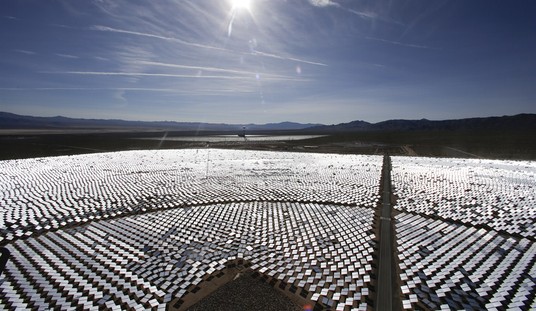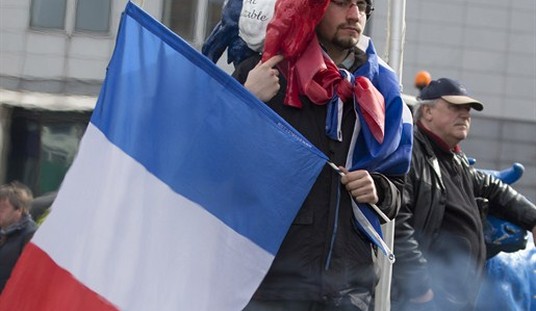In the Barack Obama presidency, no name brings out conspiracy theorists as much as Valerie Jarrett. Perhaps Noam Scheiber at The New Republic intended his Jarrett profile to dispel the common perception of Jarrett as a Machiavellian figure, or even a Svengali. If so, Scheiber has missed the mark somewhat. Jarrett comes across as manipulative, both for Obama’s benefit but most definitely her own, and ruling the White House by fear, intimidation, and strategic acts of kindness (via Instapundit):
Even at this late date in the Obama presidency, there is no surer way to elicit paranoid whispers or armchair psychoanalysis from Democrats than to mention the name Valerie Jarrett. Party operatives, administration officials—they are shocked by her sheer longevity and marvel at her influence. When I asked a longtime source who left the Obama White House years ago for his impressions of Jarrett, he confessed that he was too fearful to speak with me, even off the record. . . .
Jarrett holds a key vote on Cabinet picks (she opposed Larry Summers at Treasury and was among the first Obama aides to come around on Hillary Clinton at State) and has an outsize say on ambassadorships and judgeships. She helps determine who gets invited to the First Lady’s Box for the State of the Union, who attends state dinners and bill-signing ceremonies, and who sits where at any of the above. She has placed friends and former employees in important positions across the administration—“you can be my person over there,” is a common refrain.
And Jarrett has been known to enjoy the perks of high office herself. When administration aides plan “bilats,” the term of art for meetings of two countries’ top officials, they realize that whatever size meeting they negotiate—nine by nine, eight by eight, etc.—our side will typically include one less foreign policy hand, because Jarrett has a standing seat at any table that includes the president.
Even Scheiber admits to the ego-stroking that keeps Obama in a bubble:
They complain that she has too much control over who sees the president. That she skews his decision-making with her after-hours visits. That she is an incorrigible yes-woman. That she has, in effect, become the chief architect of his very prominent and occasionally suffocating bubble.
There is an element of truth to this critique. While aboard Air Force One at the end of the 2012 campaign, Jarrett turned to Obama and told him, “Mr. President, I don’t understand how you’re not getting eighty-five percent of the vote.” The other Obama aides in the cabin looked around in disbelief before concluding that she’d been earnest.
Jarrett has slowly pushed out other voices from accessing the President. That, as Scheiber explains, amplifies her own even more:
According to a former high-level aide, there is no longer a daily meeting between the president and his top advisers. Under the old system, if the president waved off one adviser’s objection to his preferred plan of action, another could step in to vouch for the objection’s merit. The advice Obama gets now, though, comes more regularly through one-off interactions with the likes of Jarrett and Denis McDonough, who don’t have anyone else to back them up. In the second term, observes the former aide, “Maybe the president says, more often than in the past, ‘We’re doing it.’”
The result is that Obama has become even more persuaded of his righteousness as the years have gone on.
Under a system such as this, it’s no wonder that the President could argue with a straight face that the midterm elections had nothing to do with him, even after explicitly declaring that “every single one” of his policies were on the ballot.
Still, this is similar to the myriad of Karl Rove ghost stories that abounded throughout George W. Bush’s presidency. Remember the “Bush’s Brain” meme? Supposedly Rove was the eeeeeeevil genius pulling the strings, at least when Dick Cheney was otherwise occupied, and Bush was just caught up in a bubble of sycophancy and flat-out denial. Democrats took aim at Rove during the second term, hoping to marginalize him and therefore damage Bush, and they certainly succeeded at damaging Rove. Otherwise, Bush stuck to his own path throughout the rest of his term, although he did try to work with a newly-Democratic Congress more than we can probably expect Obama to do so with Capitol Hill now under control of the Republicans.
The Jarrett-as-Svengali meme looks similarly pointless. Even if what Scheiber reports is entirely accurate (and there is no reason to think it’s not), the bubble in which Obama finds himself is entirely his fault, not Jarrett’s. After all, Obama is in charge, and can set up his White House any way that suits him. Jarrett may or may not be a counterproductive presence or even a malignant one, but it’s the failure of Obama as an executive that created and perpetuates that situation. He wouldn’t be the first executive to surround himself with yes-people to keep from having to seriously consider the possibility that he’s entirely wrong. The result of that kind of executive incompetence is exactly what we’ve seen from the Obama presidency, so Scheiber’s work is more of a confirmation than a revelation.
Jarrett may be Barack Obama’s problem, but she’s not the voters’ problem. She’s a side effect. Barack Obama is the voters’ problem.
Update: Ben Domenech argues that Jarrett is becoming the Left’s Dick Cheney — an excuse for Obama’s failures.








Join the conversation as a VIP Member